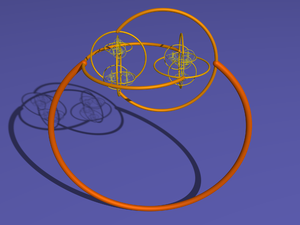Benutzer:TobeStar81/Gehörnte Sphäre
Wenn du dies liest:
|
Wenn du diesen Artikel überarbeitest:
|
Die Gehörnte Sphäre ist eine wilde Einbettung einer Sphäre in den und wurde von J.W. Alexander entdeckt. Diese Entdeckung ist sowohl für die Topologie, als auch für die Differentialgeometrie als Gegenbeispiel für verschiedene Annahmen bedeutsam.
Konstruktion
Eine mögliche Konstruktion ist wie folgt:
- Man schneidet einen im 3-dimensionalem euklidischen Raum eingebetteten Torus entlang eines um den Torus-Körper liegenden Ringes auf und erhält so einen eingebetteten Zylinder.
- An jeweils einem Ende dieses Zylinders klebt man nun einen weiteren Torus, aus dem man eine eingebettete Kreisscheibe entfernt hat, entlang der Ränder. Diese beiden angeklebten Tori sind miteinander verschränkt (vgl. Hopf link).
- Die Schritte 1.-2. werden induktiv unendlich oft wiederholt.
Test1
blabla
Test2
blubb
The Alexander horned sphere is a wild embedding of a sphere into space, discovered by Vorlage:Harvs. It is the particular embedding of a sphere in 3-dimensional Euclidean space obtained by the following construction, starting with a standard torus:
- Remove a radial slice of the torus.
- Connect a standard punctured torus to each side of the cut, interlinked with the torus on the other side.
- Repeat steps 1–2 on the two tori just added ad infinitum.
By considering only the points of the tori that are not removed at some stage, an embedding results of the sphere with a Cantor set removed. This embedding extends to the whole sphere, since points approaching two different points of the Cantor set will be at least a fixed distance apart in the construction.
The horned sphere, together with its inside, is a topological 3-ball, the Alexander horned ball, and so is simply connected; i.e., every loop can be shrunk to a point while staying inside. The exterior is not simply connected, unlike the exterior of the usual round sphere; a loop linking a torus in the above construction cannot be shrunk to a point without touching the horned sphere. This shows that the Jordan–Schönflies theorem does not hold in three dimensions, as Alexander had originally thought. Alexander also proved that the theorem does hold in three dimensions for piecewise linear/smooth embeddings. This is one of the earliest examples where the need for distinction between the topological category of manifolds, and the categories of differentiable manifolds, and piecewise linear manifolds was noticed.
Now consider Alexander's horned sphere as an embedding into the 3-sphere, considered as the one-point compactification of the 3-dimensional Euclidean space R3. The closure of the non-simply connected domain is called the solid Alexander horned sphere. Although the solid horned sphere is not a manifold, R. H. Bing showed that its double (which is the 3-manifold obtained by gluing two copies of the horned sphere together along the corresponding points of their boundaries) is in fact the 3-sphere. One can consider other gluings of the solid horned sphere to a copy of itself, arising from different homeomorphisms of the boundary sphere to itself. This has also been shown to be the 3-sphere. The solid Alexander horned sphere is an example of a crumpled cube; i.e., a closed complementary domain of the embedding of a 2-sphere into the 3-sphere.
One can generalize Alexander's construction to generate other horned spheres by increasing the number of horns at each stage of Alexander's construction or considering the analogous construction in higher dimensions.
Other substantially different constructions exist for constructing such "wild" spheres. Another example, also found by Alexander, is Antoine's horned sphere, which is based on Antoine's necklace, a pathological embedding of the Cantor set into the 3-sphere.
See also
References
- “An Example of a Simply Connected Surface Bounding a Region which is not Simply Connected”, in Proceedings of the National Academy of Sciences of the United States of America, volume 10, issue 1, National Academy of Sciences, 1924, ISSN 0027-8424, JSTOR 84202, pages 8–10
- “A homeomorphism between the 3-sphere and the sum of two solid horned spheres”, in Annals of Mathematics. Second Series, volume 56, 1952, ISSN 0003-486X, JSTOR 1969804, pages 354–362
- D. Fuchs, S. Tabachnikov, Mathematical Omnibus: Thirty Lectures on Classic Mathematics
==External links==
*{{mathworld|urlname=AlexandersHornedSphere|title=Alexander's Horned Sphere}}
*Zbigniew Fiedorowicz. Math 655 – Introduction to Topology. [http://www.math.ohio-state.edu/~fiedorow/math655/] – Lecture notes
*[http://www.youtube.com/watch?v=d1Vjsm9pQlc Construction of the Alexander sphere]
*[http://www.ultrafractal.com/showcase/jos/alexanders-horn.html rotating animation]
*[http://pouet.net/prod.php?which=30253 PC OpenGL demo rendering and expanding the cusp]
[[Category:Geometric topology]]
[[Category:Topology]]
[[Category:Fractals]]
[[ca:Esfera banyuda d'Alexander]]
[[es:Esfera cornuda de Alexander]]
[[fr:Sphère cornue d'Alexander]]
[[ko:알렉산더의 뿔 달린 구]]
[[it:Sfera di Alexander]]
[[pl:Rogata sfera Alexandera]]
[[ru:Дикая сфера]]

